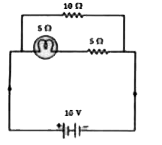InterviewSolution
Saved Bookmarks
| 1. |
A current of 1 ampere flows in a series circuit containing an electric lamp and a conductor of 5Omega when connected to a 10 V battery. Calculate the resistance of the electric lamp. Now if a resistance of 10Omega is connected in parallel with this series combination, what change [if any] in current flowing through 5Omega conductor and potential difference across the lamp will take place? Give reason. |
|
Answer» Solution :Given: In a SERIES CIRCUIT containing lamp and resistor, `I=IA,R_(L)=?R_(C)=5Omega,V=10V` Using Ohm.s law, `V=1R_(S)` `V=1[R_(L)+R_(C)]` `10=1[R_(L)+5]` `R_(L)=5Omega`. So, RESISTANCE of an electrical lamp is `5Omega`. According to the given condition, circuit can be redrawn as shown.  So, effective resistance of parallel combination, `1/R_(P)=1/R_(2)+1/R_(S)` = `1/R_(2)+1/(R_(L)+R_(1))` = `1/10+1/(5+5)=1/10+1/10=1/5` Therefore, `R_(P)=5Omega` Current drawn from the battery `I=V/R=10/5=2A` As in parallel combination, potential difference across them remains same. So, `I_(1)R_(AB)=I_(2)R_(CD)` `rArrI_(1)/I_(2)=R_(CD)/R_(AB)=10/10=1` `rArrI_(1)=I_(2)` i.e., Current is divided in both the arms equally. So, `I_(1)=I_(2)=IA`. Hence, there will be no change in the current through `5Omega` conductor. ALSO there will be no change in the potential difference across the lamp as in both cases, current through the lamp remains same i.e. IA. |
|